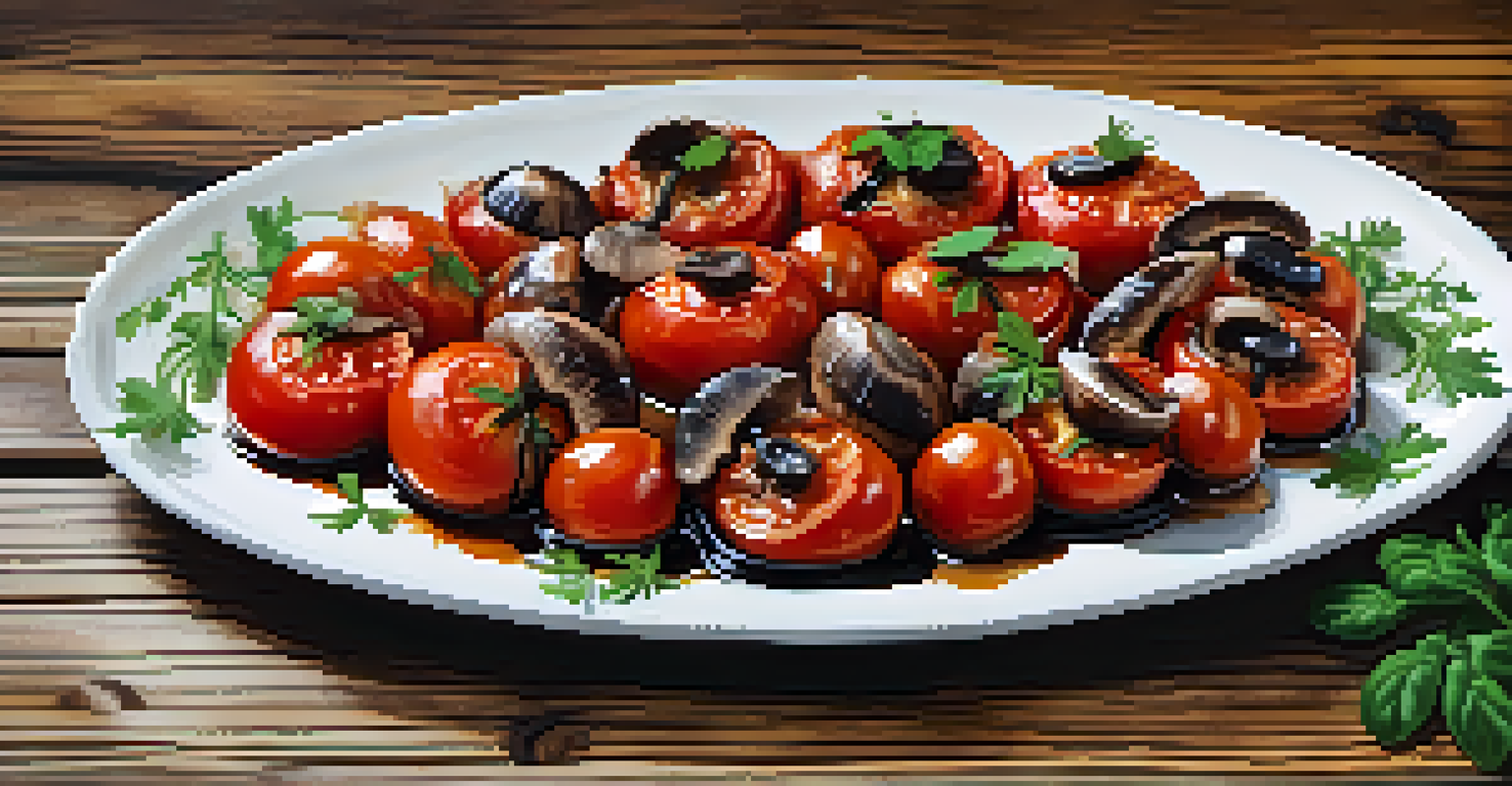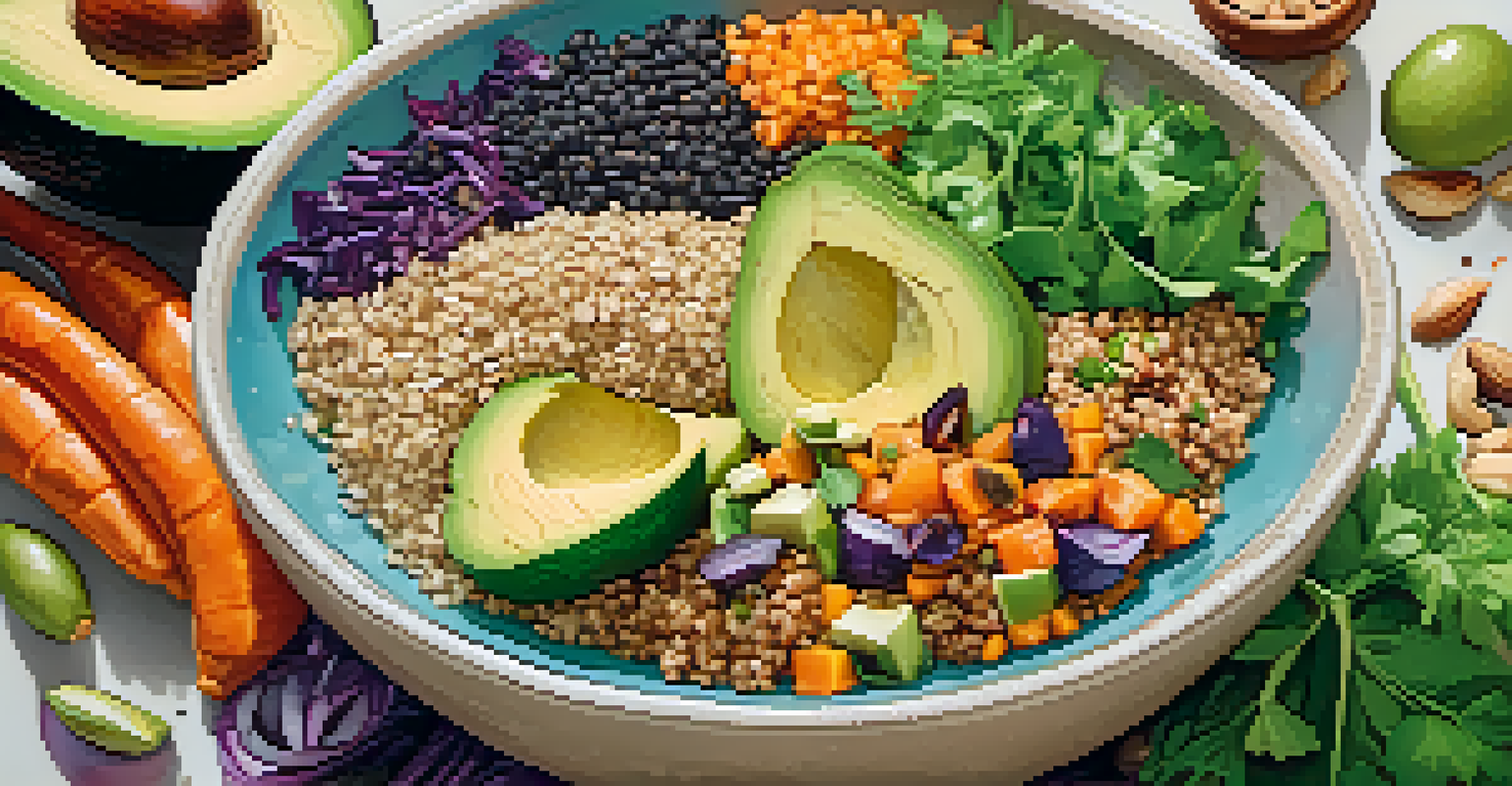Umami in Vegan Cooking: Ingredients to Elevate Flavor

Understanding Umami: The Fifth Taste in Cooking
Umami, often referred to as the 'fifth taste,' adds a savory depth to dishes. It's a flavor profile that goes beyond salty, sweet, sour, and bitter, creating a more rounded taste experience. Imagine biting into a perfectly ripe tomato or savoring a rich mushroom broth; that's umami at work. For vegans, mastering umami can transform simple meals into culinary delights.
Umami is the taste that brings people together. It is the universal flavor that makes food enjoyable and satisfying.
The term 'umami' is derived from Japanese, meaning 'pleasant savory taste.' It was identified as a distinct flavor by Professor Kikunae Ikeda in the early 20th century. Foods rich in umami include tomatoes, mushrooms, and fermented products. Understanding this flavor can help vegan cooks create dishes that satisfy even the most discerning palate.
Incorporating umami into vegan cooking is essential for creating memorable meals. By focusing on ingredients that pack this flavor punch, you can elevate your dishes from bland to bold. Let's dive into some key ingredients that can help you harness umami in your vegan creations.
Mushrooms: A Versatile Umami Powerhouse
Mushrooms are often the go-to ingredient for adding umami to vegan dishes. Varieties like shiitake, portobello, and cremini are particularly rich in this savory flavor. They can be sautéed, roasted, or used in stews, providing a hearty base for many meals. Think of them as the meat substitute in your favorite recipes, delivering both taste and texture.

One of the best ways to use mushrooms is by making a rich mushroom broth. Simmering dried mushrooms, such as porcinis, with herbs and spices creates a deeply flavorful liquid that can serve as a base for soups and sauces. This broth captures the essence of umami, enriching your dishes with minimal effort.
Umami: The Essential Fifth Taste
Understanding umami enhances vegan meals by adding savory depth and complexity.
Don't underestimate the power of mushroom powder either. Sprinkling some on popcorn or mixing it into sauces can instantly boost flavor. By experimenting with different types of mushrooms, you can discover new dimensions of umami in your cooking.
Tomatoes: The Sweet and Savory Combo
Tomatoes are another fantastic source of umami, especially when cooked. Roasting or sun-drying tomatoes concentrates their flavors, enhancing their natural sweetness and savory notes. A simple tomato sauce can become a gourmet experience with just a few ingredients and a little love in the kitchen.
Cooking is about creating a flavor experience that resonates with the soul. Umami is the secret ingredient that enhances that experience.
Consider adding tomatoes to your vegan dishes in various forms: fresh, canned, or as paste. Each offers a unique flavor profile and can elevate a dish differently. For example, tomato paste is a great way to thicken sauces while packing a flavorful punch.
When combined with herbs like basil or oregano, tomatoes create an irresistible blend that sings of umami. Adding a splash of balsamic vinegar can also intensify the flavor, making your vegan meals more vibrant and satisfying.
Fermented Foods: A Flavor Boosting Secret
Fermented foods are treasure troves of umami and can add complexity to your dishes. Ingredients like miso, soy sauce, and nutritional yeast are packed with savory goodness. They not only enhance flavor but also introduce beneficial probiotics, making your meals healthier.
Miso is particularly versatile; it can be used in soups, dressings, or marinades. Just a spoonful can transform a simple vegetable stir-fry into a gourmet dish. Similarly, soy sauce can add depth to sauces and glazes, while nutritional yeast offers a cheesy flavor without dairy.
Key Ingredients for Umami Flavor
Ingredients like mushrooms, tomatoes, and fermented foods are vital for achieving umami in vegan cooking.
Don't forget about fermented vegetables, like kimchi or sauerkraut, which can add crunch and zing to salads or grain bowls. Incorporating these foods into your vegan cooking can truly elevate your meals and keep your taste buds dancing.
Nuts and Seeds: Crunchy Umami Enhancers
Nuts and seeds might not be the first ingredients that come to mind when thinking of umami, but they play a crucial role in enhancing flavor. Almonds, walnuts, and sunflower seeds can add a delightful crunch and a hint of savory taste to dishes. When toasted, their flavors deepen, making them perfect for salads or grain bowls.
Nut butters, like tahini or almond butter, can create creamy sauces with a nutty undertone. These can be used in dressings or dips, adding richness and umami without the need for animal products. Imagine a tahini sauce drizzled over roasted vegetables—pure bliss!
In addition, crushed nuts can serve as a topping for pasta or casseroles, providing texture and flavor. By incorporating various nuts and seeds into your meals, you can achieve a satisfying balance of flavors that keep your dishes interesting.
Sea Vegetables: Oceanic Flavors in Your Kitchen
Sea vegetables, such as nori, dulse, and kombu, are excellent for introducing umami to your vegan dishes. These ingredients not only add a unique flavor but also provide essential nutrients like iodine. Adding a strip of kombu to your cooking water can infuse your grains with a subtle oceanic flavor.
Nori, commonly used for sushi, can be crumbled and sprinkled over salads or soups for an extra flavor boost. Its umami profile enhances the dish while offering a crunchy texture. Similarly, dulse can be used as a seasoning for popcorn or roasted vegetables, adding a savory depth that’s hard to resist.
Layering Flavors for Culinary Delight
Building layers of umami-rich ingredients transforms simple vegan dishes into flavorful masterpieces.
Incorporating sea vegetables into your cooking can transport your taste buds to the coast. Whether you’re making a sushi bowl or a hearty stew, these ingredients can elevate your vegan creations with their unique flavors.
Spices and Herbs: The Unsung Heroes of Umami
While spices and herbs may not be traditionally associated with umami, they can significantly enhance flavor in vegan cooking. Ingredients like smoked paprika, garlic powder, and cumin can add depth and richness to your dishes. A sprinkle of these spices can elevate a simple vegetable stir-fry into a culinary masterpiece.
Herbs like basil, thyme, and rosemary can also contribute to umami. When combined with other umami-rich ingredients, they create a symphony of flavors that tantalize the palate. Think of a hearty vegetable soup enriched with fresh herbs and a dash of soy sauce—delicious!

Experimenting with different spice blends can lead to delightful discoveries. Consider making your own blend using umami-enhancing spices to add a personal touch to your cooking. With just a little creativity, you can transform everyday meals into unforgettable experiences.
Building Layers of Flavor: A Culinary Adventure
When it comes to vegan cooking, the key to achieving umami is all about building layers of flavor. By combining various umami-rich ingredients, you can create depth and complexity in your dishes. Think of it like creating a beautiful painting—each element adds to the overall masterpiece.
Start by selecting a base ingredient, like mushrooms or tomatoes, then layer on flavors with fermented foods, nuts, and spices. Don’t hesitate to experiment with different combinations to find what resonates with your taste buds. Each meal becomes an opportunity to discover new flavor profiles and textures.
Ultimately, the journey of mastering umami in vegan cooking is a rewarding one. With a little practice and imagination, your kitchen can become a playground of flavors that leave everyone asking for seconds. Embrace the adventure, and let your culinary creativity shine!